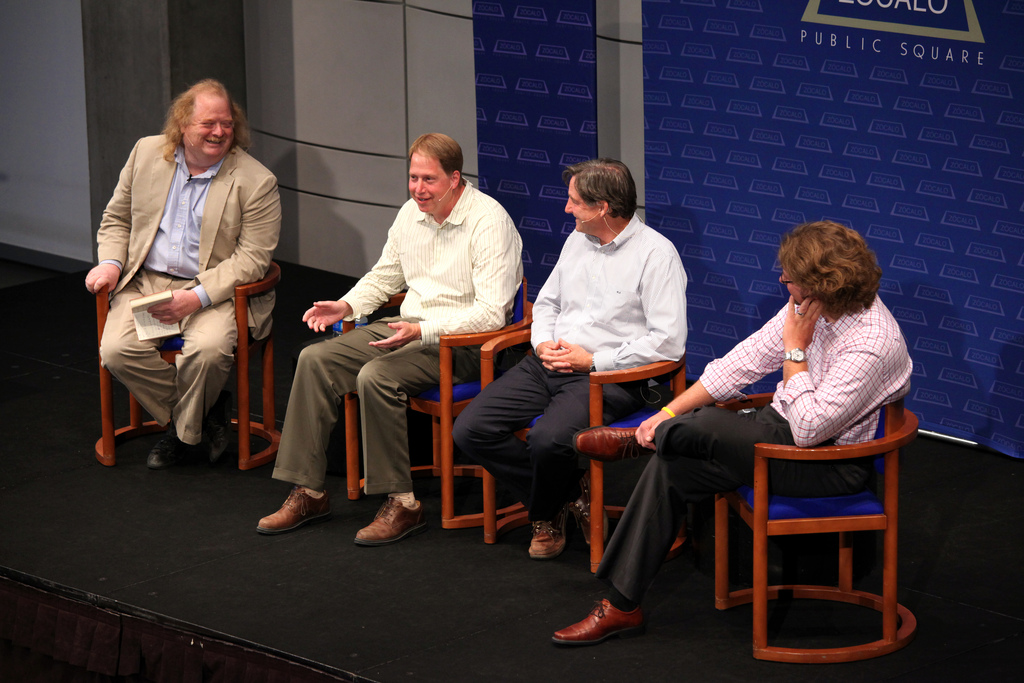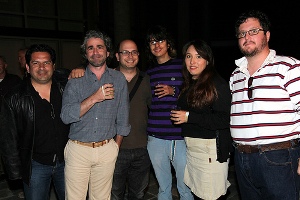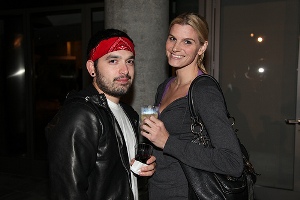
Even though it was 15 years ago, Jonathan Gold remembers an unnerving conversation with Campanile chef Mark Peel about fish: Peel predicted then that in 40 years, eating wild fish would be as odd as eating wild game.
“Now, only 15 years later, it seems almost frighteningly close to being true,” said Gold to the full house at the Skirball Cultural Center.
Gold joined his brother and Heal the Bay President Mark Gold, Santa Monica Seafood’s Logan Kock, and Providence chef Michael Cimarusti to see whether our seafood diets are long for this world, what we should be eating, and whether labels and laws can save ocean ecosystems.
Infants the size of whales
As Mark Gold explained, gauging the extent of the fishing problem can be difficult: marine ecologists and ocean population experts estimate that somewhere between 25 and 75 percent of the world’s fisheries are in a state of drastic decline. It’s a wide range, Gold acknowledged. “But the one thing everyone would agree on is that it’s dramatically worse today than it was even a decade ago,” he said, making the need to move to sustainable fishing practices a critical one.
 Kock was a bit more optimistic about the state of the oceans, and the ability of the American government to do something about it in the next few years. “Things are worse than they were 10 years ago, but I think they’re better than they were five years ago,” he said, given the increasing awareness among governments, buyers like Kock, farmers and restaurateurs. Kock noted that certain species, like swordfish, are rising again.
Kock was a bit more optimistic about the state of the oceans, and the ability of the American government to do something about it in the next few years. “Things are worse than they were 10 years ago, but I think they’re better than they were five years ago,” he said, given the increasing awareness among governments, buyers like Kock, farmers and restaurateurs. Kock noted that certain species, like swordfish, are rising again.
Still, as Mark Gold pointed out and as Kock agreed, other countries aren’t doing as well. Many developing nations are selling their fishing rights for cash, leaving local fishermen without product. Cimarusti noted that prices abroad push down the selling ability of local American fishermen. Jonathan Gold noted that farming practices pollute the oceans and breed genetically modified fish. “Not only are salmon not allowed to be salmon, but you’re basically eating infants that are the size of whales,” he said.
Mark Gold emphasized that there’s no agreement on how to manage fisheries globally, and governments don’t have a strong track record with such legislation. “Pick an issue other than the Montreal protocol or CFCs, and there’s very little in the way of success,” he said. Other countries are also consuming more seafood or pursuing unsustainable methods of catching it.
Sticking to locally caught fish, however, can be difficult, as Cimarusti said. The California options – anchovies, squid – might not do so well on a menu with wild Alaskan halibut or king salmon. “I still think most people would rather have wild Alaskan salmon than grilled sardines. I certainly don’t blame them for that,” Cimarusti said. “I have to buy fish that I think people want to eat.”
Bluefin and tater tots
One such fish seems to be bluefin tuna, one of the few truly “global fish,” as Cimarusti put it, and the most commodified in the world. “At one point it was cod, but that’s not the case anymore because it’s gone,” he said. Cimarusti’s Providence hasn’t served it in years – crucial, as Kock pointed out, considering that 75 to 80 percent of seafood consumption in the U.S. occurs in restaurants. “Chefs probably have the strongest voice out there, and in a way the biggest responsibility,” Kock said, adding that he doesn’t sell bluefin tuna.
Cimarusti noted that Providence doesn’t serve bluefin, and the decision wasn’t difficult because the fish isn’t and has never been a staple food. “No one is going to die if we stop fishing for bluefin tuna. It’s not rice. It’s not bread,” he said. He also dismissed cultural or rights arguments to fishing the species.
 But without a treaty that prevents selling them across international lines, the fish is in danger as a species. Cimarusti advocated a complete moratorium in the Gulf and along the Eastern seaboard for up to a decade to give the fish time to recover. Mark Gold noted that existing legislation is doing little to save bluefin tuna, and he doubted that other regulations could work, prompting Cimarusti to turn to the crowd.
But without a treaty that prevents selling them across international lines, the fish is in danger as a species. Cimarusti advocated a complete moratorium in the Gulf and along the Eastern seaboard for up to a decade to give the fish time to recover. Mark Gold noted that existing legislation is doing little to save bluefin tuna, and he doubted that other regulations could work, prompting Cimarusti to turn to the crowd.
“Raise your hand and pledge against bluefin tuna,” Cimarusti said, as the audience followed along. “Let’s do it right now.”
And even though the panelists agreed that habits die hard, Cimarusti said, “I don’t eat tater tots but I’m perfectly fine with that.”
“You’re missing out,” Mark Gold said.
Remember abalone
Where habits are hard to change, regulation could lead the way, the panelists noted. Cimarusti pointed out that the seafood industry is nowhere near as well- or thoroughly-regulated as the beef industry in the U.S. Kock cited the success of the Marine Stewardship Council in evaluating sustainable fisheries and labeling their stock as such, leading to the positive management of fish like Chilean sea bass. The only caveat, Kock said, was the royalties the company charges for its label. The royalty means that products that bring in less money, like squid, can’t afford to carry the labels. Jonathan Gold also noted that the agency has made some questionable approvals. Kock agreed that the effort wasn’t perfect.
Mark Gold and Kock also noted that they’re part of an effort to regulate seafood in California by a labeling process. But Gold did note that much California seafood comes from out of state. Proposed marine protection areas, he added, may not be successful either, because of the infighting between sports and commercial fisherman and ecologists. Big sport fishing areas like Rocky Point on the Palos Verdes Peninsula may not be protected, even though it’s the most ecologically important area in the region, Gold said: “It’s not like the recommendations are being made by marine scientists.”
Not all individual fishing is bad. Cimarusti recalled Californians years ago diving for and eating abalone, along with residents of his native Rhode Island eating what they could catch. “People feel they have this right to whatever they can avail themselves of,” he said. “I think it’s very healthy and something we should strive to get back to.”
Worms, squirts, rays, jellyfish
 And there’s more than abalone to eat, the panelists noted.
And there’s more than abalone to eat, the panelists noted.
“Are you going to talk to us about eating live octopus now?” Mark Gold asked his brother.
“I’ve had it,” Cimarusti said. “I liked it.”
“Have you had it braised for a long time til it gets really soft?” Jonathan asked of sea cucumber.
“See what I have to live with?” Mark said. Cimarusti and Jonathan recalled eating sea squirts and sea worms, which Jonathan described as “sickly long wagging pink penises.” Cimarusti said the worms had the texture of a garden hose; Jonathan described squirts as something like “hard rubber balls.”
Kock chimed in with a more serious suggestions, noting the broad but effective red-green-yellow rubric of what’s safe to eat. He also named the Chesapeake Ray, an intermediary on the food chain that now lacks enough predators (sharks) or prey, like oysters. “We become the sharks,” Kock said. While Mark worried about restaurants starting to serve manta ray instead, Jonathan remembered a delicious ray soup and lamented the process of actually cooking the barbed animal. Kock added that “The meat is more like veal,” while Cimarusti seemed eager to try some.
When all else fails, Jonathan Gold had a suggestion. “Really eat as much jelly fish as you can. Feed it to your dog. Feed it to your cat,” he said. “Pretend it’s snow at Christmas time.”
Mark Gold had a final tip for what not to eat. “The worst salmon I ever had,” he said, turning to his brother, “was at your Pulitzer award dinner.”
Jonathan replied, “And I had 120 people thinking they were being bright and original by asking me to review the lunch.”
Watch the video here.
See more photos here.
Read In The Green Room Q&As with Michael Cimarusti, Jonathan Gold, Mark Gold, and Logan Kock.
Read five food fans – Kogi chef Roy Choi, Teenage Glutster Javier Cabral, Artbites’ Maite Gomez-Rejón, photographer Charlie Grosso, and Eater LA’s Kat Odell – discuss the cruelest foods they’ve ever eaten.
*Photos by Aaron Salcido.




Send A Letter To the Editors